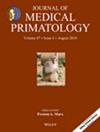人偏肺病毒研究中的生物趋同和非人灵长类动物模型
IF 0.5
4区 农林科学
Q3 VETERINARY SCIENCES
引用次数: 0
摘要
人偏肺病毒(HMPV)对全球健康构成重大威胁。虽然非人灵长类动物(NHPs)仍然是重要的模型,但伦理和经济限制需要补充方法。先进的生物融合技术,包括类器官、人工智能(AI)和量子计算,提供了可扩展、具有成本效益和合乎道德的解决方案,加强了HMPV研究、抗病毒药物开发和未来的临床应用。本文章由计算机程序翻译,如有差异,请以英文原文为准。
Bioconvergence and Non-Human Primate Models in Human Metapneumovirus Research
Human metapneumovirus (HMPV) poses a significant global health threat. While nonhuman primates (NHPs) remain crucial models, ethical and economic limitations necessitate complementary approaches. Advanced bioconvergence technologies, including organoids, artificial intelligence (AI), and quantum computing, offer scalable, cost-effective, and ethical solutions, enhancing HMPV research, antiviral development, and future clinical applications.
求助全文
通过发布文献求助,成功后即可免费获取论文全文。
去求助
来源期刊
CiteScore
1.40
自引率
42.90%
发文量
62
审稿时长
6 months
期刊介绍:
The Journal of Medical Primatology publishes research on non-human primates as models to study, prevent, and/or treat human diseases; subjects include veterinary medicine; morphology, physiology, reproductive biology, central nervous system, and cardiovascular diseases; husbandry, handling, experimental methodology, and management of non-human primate colonies and laboratories; non-human primate wildlife management; and behaviour and sociology as related to medical conditions and captive non-human primate needs.
Published material includes: Original Manuscripts - research results; Case Reports - scientific documentation of a single clinical study; Short Papers - case histories, methodologies, and techniques of particular interest; Letters to the Editor - opinions, controversies and sporadic scientific observations; Perspectives – opinion piece about existing research on a particular topic; Minireviews – a concise review of existing literature; Book Reviews by invitation; Special Issues containing selected papers from specialized meetings; and Editorials and memoriams authored by the Editor-in-Chief.

 求助内容:
求助内容: 应助结果提醒方式:
应助结果提醒方式:


